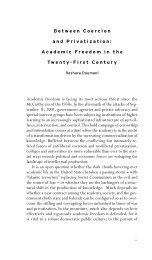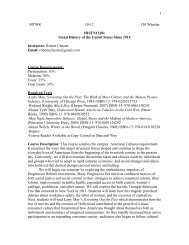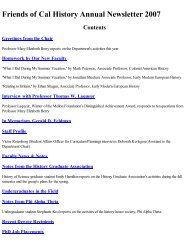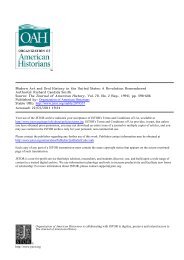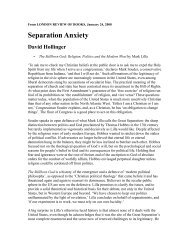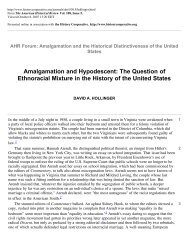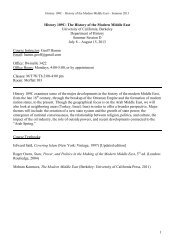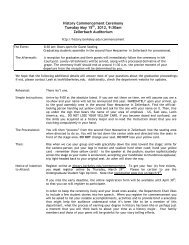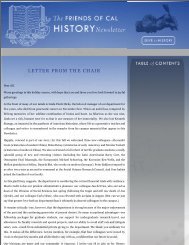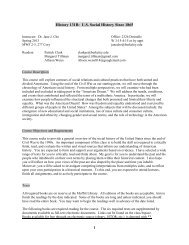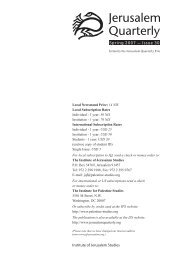Reading Historiography - Department of History, UC Berkeley
Reading Historiography - Department of History, UC Berkeley
Reading Historiography - Department of History, UC Berkeley
You also want an ePaper? Increase the reach of your titles
YUMPU automatically turns print PDFs into web optimized ePapers that Google loves.
"The 'underclass' debate has moved in three – sometimes overlapping – directions. The first,<br />
and most influential, focuses on the behavior and values <strong>of</strong> the poor, and the role <strong>of</strong> federal<br />
social programs in fostering a culture <strong>of</strong> joblessness and dependency in inner cities …. The<br />
second <strong>of</strong>fers structural explanations for inequality and urban poverty …. A third explanation<br />
focuses on politics, emphasizing the marginalization <strong>of</strong> cities in American social policy,<br />
particularly in the aftermath <strong>of</strong> the urban unrest and racial conflict <strong>of</strong> the 1960s …. [W]hat is<br />
largely missing from the 'underclass' debate is the perspective <strong>of</strong> history. My examination <strong>of</strong><br />
Detroit in the quarter-century after World War II suggests …"<br />
What is the question (or questions) to which the work <strong>of</strong> historiography <strong>of</strong>fers an answer?<br />
Historians arrive at their projects in a number <strong>of</strong> ways. Sometimes they identify (or stumble<br />
upon) a curious or anomalous set <strong>of</strong> circumstances or confluence <strong>of</strong> historical events. Other<br />
times, they are driven by more presentist concerns - a current issue or event whose historical<br />
lineage they'd like to trace. Still other times, perhaps most <strong>of</strong> the time, they simply have an issue<br />
or event from the past about which they'd like to know more. Starting points such as these, in<br />
turn, give rise to a research question or questions to which historians propose to <strong>of</strong>fer an answer<br />
(or, more accurately, an interpretation or argument). Sometimes historians make that question<br />
explicit to their readers, usually in the introduction. Sometimes it's only implicit. Identifying the<br />
question to which a work <strong>of</strong> historiography proposes to give an answer <strong>of</strong>ten provides an<br />
important leverage point for grappling with the onslaught <strong>of</strong> historical details that follow. Here is<br />
an example to illustrate:<br />
Ruth Feldstein, Motherhood in Black and White: Race and Sex in American Liberalism,<br />
1930-1965 (Ithaca: Cornell University Press, 2000), 1:<br />
When I ask students to describe the 1950s, they <strong>of</strong>fer two types <strong>of</strong> adjectives and images.<br />
Conservative, suburban, apathetic, they begin. Stay-at-home mothers in aprons, fathers<br />
coming home from work, teenage girls in poodle skirts at high school dances – these are<br />
some <strong>of</strong> the images that come to the minds <strong>of</strong> those reared on reruns <strong>of</strong> Happy Days and<br />
Leave It to Beaver. But many <strong>of</strong> these same students also associate this period with the early<br />
years <strong>of</strong> the civil rights movement: they use adjectives like rebellious, courageous, and<br />
dignified to describe Rosa Parks in Montgomery, Alabama, the "Little Rock Nine" in<br />
Arkansas, and other icons <strong>of</strong> grassroots activism.<br />
I began this book with similar associations. It was not clear to me what they had to do<br />
with each other. It was difficult to understand why, what Betty Friedan later called the<br />
"feminine mystique," flourished in the same era that the civil rights movement gained<br />
momentum. How was it that liberal ideas about race relations gained ascendance in the same<br />
period that conservative ideas about gender relations seemed so entrenched?<br />
What is the thesis? The thesis is the analytical heart and soul <strong>of</strong> any work <strong>of</strong> historiography.<br />
Thesis statements almost always appear somewhere in the introduction. They may vary in length<br />
from a few sentences to a few pages. They may be straightforward or multifaceted, comprised <strong>of</strong><br />
a number <strong>of</strong> different strands or sub-theses. Sometimes the historian cues you into the thesis<br />
with statements such as "I argue," or "I contend," etc. Other times the thesis is less explicitly<br />
presented. Whether explicit or implicit, the thesis is the interpretive posture assumed, argument<br />
to be made, position to be defended, etc., in its most pithy analytic articulation. If history is, as<br />
an old adage goes, philosophy reasoning by example, then the thesis statement <strong>of</strong> any historical<br />
2



